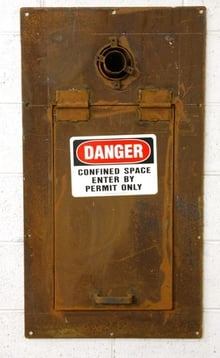Keeping Workers Safe When in Confined Spaces

The beginning of August is just right around the corner, and with it, the new Construction Confined Space Rules (26 CFR 1926 Subpart AA) comes into effect. For the most part, it resembles the General Industry Confined Space Standard (29 CFR 1910.146), but there are some key differences that employers and safety professionals should be aware of.
Even if your employees do not enter confined spaces, employers are still required to “take effective steps to prevent [their] employees from entering the space.”
Multi-Employer Worksites
Typical construction sites are a flurry of activity. It is unlikely that any employer, unless planned, is the only contractor/subcontractor operating on a site at one time. Most of the time, there are at least a few different contractors on sites, depending on the size, scale, and complexity of the project.
For the new standard, the onus of responsibility is placed directly on the host employer. As part of a risk communication process, the host employer should disclose locations, actual/potential hazards, and previous precautions/controls used for entering the space.
Additionally, the host employer, controlling contractor, and entry employer have responsibilities for when coordination is needed between multiple parties entering the same confined space. Also, it requires an information exchange following closure of the entry permit and confined space operations, in order to ensure the controlling contractor and host employer are aware of new or changing hazards found or created in the confined space.
ANSI/ASSE A.10-2011 Safety & Health Program Requirements for Multiemployer Projects is a consensus standard that is useful in helping create a verifiable system for permit-required confines spaces and multiple employer projects.
Competent Person Evaluation of the work site and Confined Spaces, Including Permit Spaces
Other regulations, like General Industry Fall Protection, have competent person requirements. The addition of this requirement highlights the need for qualified personnel on the jobsite. One person will be accountable for the identification of existing and potential (predictable) hazards with respect to confined space.
The competent person should be involved with entry planning as a subject matter expert. Even though the competent person is not required to participate in the follow up, due consideration should be given here, as their awareness of new or changing hazards in the space is beneficial to future entries.
Continuous Atmospheric Monitoring (whenever possible)
This seems like a given, although it is not required by the letter of the law. The crux of the matter is, and anyone who’s worked in a confined space can attest, the environment or atmosphere within a confined space can and does change. It can be caused by work that’s occurring, hazards that personnel are aware of, and infrequently, hazards that are potential or weren’t considered as part of the risk assessment.
Continuous atmospheric monitoring should be conducted even when ventilation and other controls are in place. As a reminder, the first atmospheric test should be done without controls as a baseline for conditions in the confined space.
Continuous Monitoring of Engulfment Hazards
One of the tricky parts of dealing with hazards on s construction site, is that the hazards can, and do, change. Frequently, these occur without warning, and condition changes in the confined spaces have been tied to incidents and deaths. Monitoring provides layer of protection against environmental changes in the space for the protection of occupants.
For a quick refresher, the order of the process for atmospheric monitoring involves monitoring for oxygen, flammability, and toxic gases. Oxygen levels should be in between 19.5-23.5%. Flammable gases should not be greater than 10% of the LFL (lower flammable limit) for gases, vapors, mists, or combustible dusts. Toxic gases should be below the PEL (permissible exposure limit)/TLV (threshold limit value) or TWA (time-weighted average) of a substance.
Keep in mind that operation within the space or equipment place in proximity to ventilation or entry/exit points can affect the atmospheric conditions in the space. Welding and burning operations can produce toxic fumes, and generators / compressors can push exhaust fumes into the space.
Suspension of Permits
With respect to permit-required confined spaces, the construction rule provides a bit more flexibility than the general industry rule. For general industry, any changes to the risks or environment in the space that are not noted on the confined space permit require cancellation of the permit.
In construction, the permit is allowed to be suspended, provided that the conditions can be returned to those listed on the permit before re-entry. This requirement is less stringent than the general industry clause, and employers who have to comply with both 1910 and 1926 should consider the stronger of the two for consistency, and preventing the opportunity for field interpretations.
The consensus standard ANSI/ASSE Z117.1-2009 Safety Requirements for Confined Spaces provides no framework for the suspension of permits. Revocation of a permit seems preferable here, simply on the basis of ensuring that the qualified person or permit approval signatory remains aware of changing risks and hazards associated with the confined space.
Not Sure Where to Start?
SafetyPro Resources is here to help you with your safety challenges. Our areas of expertise include:
- Safety Management Systems
- Client Procurement Sites (ISNetworld®, Avetta®, PEC Premier®, etc.)
- Process Safety Management
- Site Safety
- Safety Compliance
- Staffing & Recruiting
- Safety Training
You can visit us on the web, or call 800.941.0714 for a free evaluation of your organization’s Confined Space written and training programs, or how you can partner with SafetyPro Resources to address your organization’s safety challenges.

















